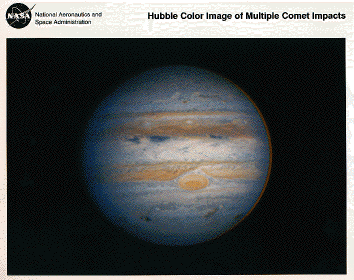

NOTE: Click on the image to view it at its highest resolution.
NASA's Hubble Space Telescope resolves eight impact sites on Jupiter from the collisions of the fragmented comet, Shoemaker Levy 9. This image was taken on July 22, 1994, shortly before the last comet fragment plunged into Jupiter's atmosphere. The impact sites appear as dark "smudges" lined up in Jupiter's southern hemisphere. The smudges are chemical debris cooked in the tremendous fireballs produced by each impact. The dark material was ejected high above the bright multicolored cloud tops. This material is now caught in the weak winds of Jupiter's upper atmosphere and will likely be dispersed in a band around the planet.
The comet crash was of tremendous significance because it represented the first time astronomers were able to predict that a comet would strike a planet, and then watch it happen. It was also a very rare event. Comets of this size strike Jupiter only once every millennium or so.
Comet Shoemaker-Levy 9 was discovered by astronomers Eugene and Carolyn Shoemaker and David Levy on a photograph taken the night of March 24,1993, with a telescope on Palomar Mountain in California. Further observations later showed that the comet was in orbit around Jupiter, and had closely passed the giant planet in July 1992. During this close approach, Jupiter's gravity broke the fragile comet into the many pieces seen in this image. Comets are"dirty snowballs," chunks of dust, and ice that formed when our Solar System was born more than 4 billion years ago. Comet Shoemaker- Levy 9 had orbited Jupiter for dozens of years.
The Hubble Space Telescope is managed by NASA's Goddard Space Flight
Center in Greenbelt, Maryland. for the OFfice of Space Science at NASA
Headquarters.
![]() Images, Images, Images
Images, Images, Images
